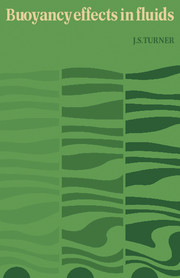Book contents
- Frontmatter
- Contents
- Preface
- 1 INTRODUCTION AND PRELIMINARIES
- 2 LINEAR INTERNAL WAVES
- 3 FINITE AMPLITUDE MOTIONS IN STABLY STRATIFIED FLUIDS
- 4 INSTABILITY AND THE PRODUCTION OF TURBULENCE
- 5 TURBULENT SHEAR FLOWS IN A STRATIFIED FLUID
- 6 BUOYANT CONVECTION FROM ISOLATED SOURCES
- 7 CONVECTION FROM HEATED SURFACES
- 8 DOUBLE-DIFFUSIVE CONVECTION
- 9 MIXING ACROSS DENSITY INTERFACES
- 10 INTERNAL MIXING PROCESSES
- Bibliography and Author Index
- Recent Publications
- Subject Index
- Plate section
10 - INTERNAL MIXING PROCESSES
Published online by Cambridge University Press: 05 August 2012
- Frontmatter
- Contents
- Preface
- 1 INTRODUCTION AND PRELIMINARIES
- 2 LINEAR INTERNAL WAVES
- 3 FINITE AMPLITUDE MOTIONS IN STABLY STRATIFIED FLUIDS
- 4 INSTABILITY AND THE PRODUCTION OF TURBULENCE
- 5 TURBULENT SHEAR FLOWS IN A STRATIFIED FLUID
- 6 BUOYANT CONVECTION FROM ISOLATED SOURCES
- 7 CONVECTION FROM HEATED SURFACES
- 8 DOUBLE-DIFFUSIVE CONVECTION
- 9 MIXING ACROSS DENSITY INTERFACES
- 10 INTERNAL MIXING PROCESSES
- Bibliography and Author Index
- Recent Publications
- Subject Index
- Plate section
Summary
The mechanisms responsible for mixing in the interior of a stratified fluid are even less well understood than those described in chapter 9, since the sources of energy are not so obvious, and several different processes must be taken into account simultaneously. The important ideas have already been introduced in earlier sections, but it seems appropriate in this final chapter to take a broader and less detailed view, and to consider together the whole array of mixing phenomena which can be relevant in large natural bodies of stratified fluid. Geophysical examples have figured prominently in this book, and indeed the range of subject matter has been chosen with this final synthesis in mind. The basic facts requiring explanation are somewhat scattered, however, and in order to collect them together and to define the problems to be treated here, a brief summary will now be given of the observed structure of the ocean and atmosphere.
This field is developing rapidly, and the interpretation given here must necessarily be a somewhat tentative and personal one. Nevertheless, it seems useful to sketch how our present knowledge of the separate components can be fitted into a self-consistent picture, at the same time extending some of the earlier arguments so that they can be applied in this wider context.
The observational data
Routine density profiles made using reversing bottles and thermometers show that the ocean is everywhere stably stratified, except for limited regions where bottom water forms intermittently as the water column becomes convectively unstable.
- Type
- Chapter
- Information
- Buoyancy Effects in Fluids , pp. 313 - 337Publisher: Cambridge University PressPrint publication year: 1973



